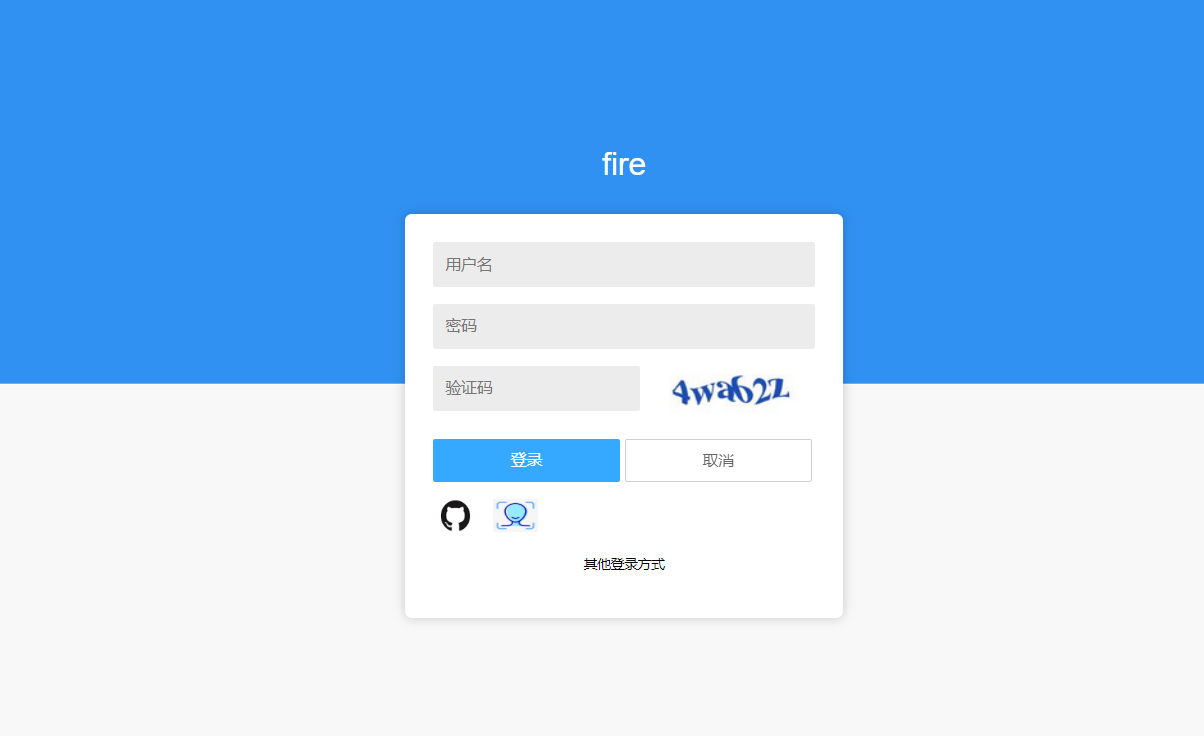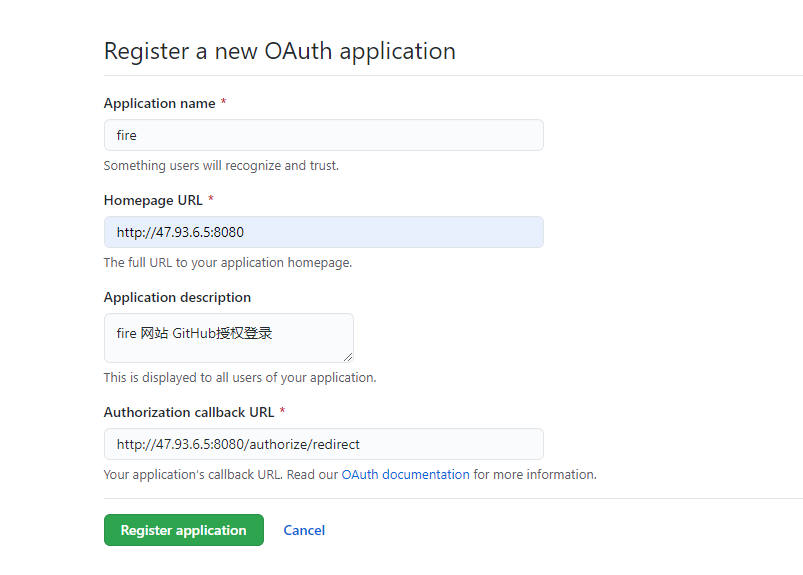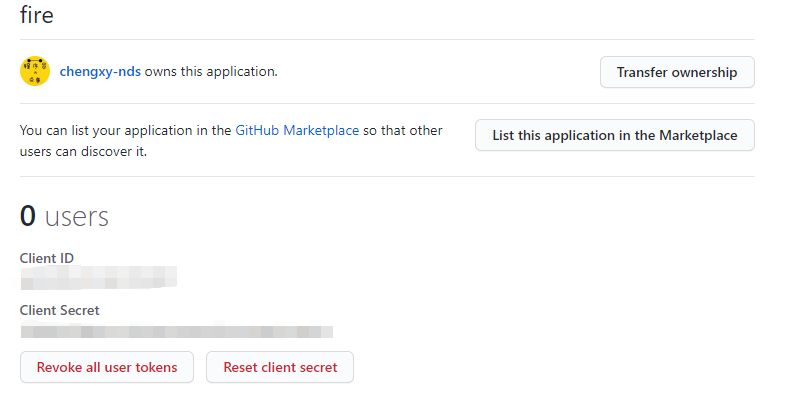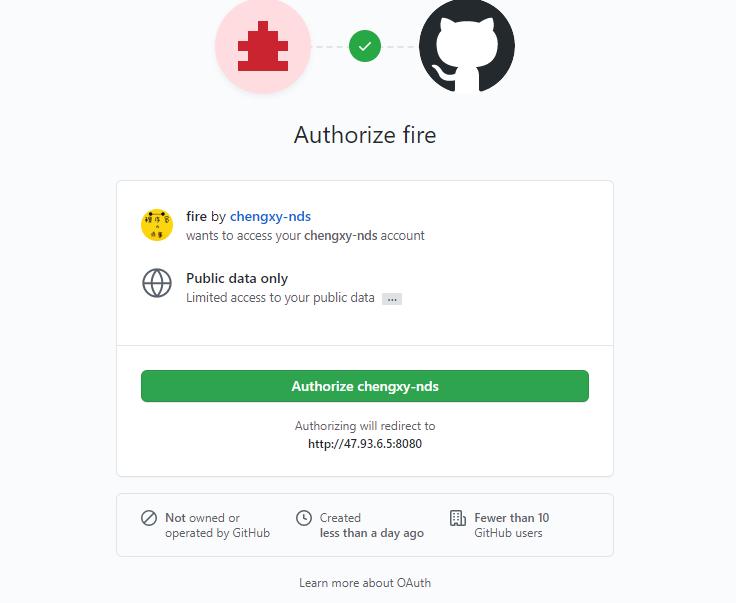本文收录在个人博客:www.chengxy-nds.top,技术资源共享。
上一篇《OAuth2.0 的四种授权方式》文末说过,后续要来一波OAuth2.0实战,耽误了几天今儿终于补上了。
最近在做自己的开源项目(fire),Springboot + vue 的前后端分离框架才搭建完,刚开始做登录功能,做着做着觉得普通账户密码登录太简单了没啥意思,思来想去为显得逼格高一点,决定再加上 GitHub授权 和 人脸识别等多种登录方式。

而GitHub授权登录正好用到了OAuth2.0中最复杂的授权码模式,正好拿我这个案例给大家分享一下OAuth2.0的授权过程,后续项目功能会持续更新。
一、授权流程
在具体做GitHub授权登录之前,咱们再简单回顾一下OAuth2.0授权码模式的授权流程,如果 fire 网站允许 用GitHub 账号登录,流程大致如下图。

用户想用GitHub 账号去登录 fire 网站:
fire网站先让用户跳转到GitHub进行授权,会弹出一个授权框。- 用户同意后,
GitHub会根据redirect_uri重定向回fire网站,同时返回一个授权码code。 fire网站使用授权码和客户端密匙client_secret,向 GitHub 请求令牌token,检验通过返回令牌。- 最后
fire网站向GitHub请求数据,每次调用 GitHub 的API都要带上令牌。
二、身份注册
梳理完授权逻辑,接下来我们还有一些准备工作。
要想得到一个网站的OAuth授权,必须要到它的网站进行身份注册,拿到应用的身份识别码 ClientID 和 ClientSecret。
注册 传送门 https://github.com/settings/applications/1334665,有几个必填项。
Application name:我们的应用名;Homepage URL:应用主页链接;Authorization callback URL:这个是github回调我们项目的地址,用来获取授权码和令牌。

提交后会看到就可以看到客户端ClientID 和客户端密匙ClientSecret,到这我们的准备工作就完事了。

三、授权开发
1、获取授权码
为了更好的看效果,获取授权码我处理的比较粗暴,直接在JS里拼装好了授权链接,但实际工作开发中一定要考虑到安全问题。
https://github.com/login/oauth/authorize?
client_id=ad41c05c211421c659db&
redirect_uri=http://47.93.6.5:8080/authorize/redirect
前端 vue 的逻辑也非常简单,只需要 window.location.href 重定向一下。
<script>
export default {
methods: {
loginByGithub: function () {
window.location.href = 'https://github.com/login/oauth/authorize?client_id=ad41c05c211421c659db&redirect_uri=http://47.93.6.5:8080/authorize/redirect'
}
}
}
</script>
请求后会提示让我们授权,同意授权后会重定向到authorize/redirect,并携带授权码code;如果之前已经同意过,会跳过这一步直接回调。

2、获取令牌
授权后紧接着就要回调 fire 网站接口,拿到授权码以后拼装获取令牌 access_token的请求链接,这时会用到客户端密匙client_secret。
https://github.com/login/oauth/access_token?
client_id=${clientID}&
client_secret=${clientSecret}&
code=${requestToken}
access_token 会作为请求响应返回,结果是个串字符,需要我们截取一下。
access_token=4dc43c2f43b773c327f97acf5dd66b147db9259c&scope=&token_type=bearer
有了令牌以后开始获取用户信息,在 API 中要带上access_token。
https://api.github.com/user?access_token=4dc43c2f43b773c327f97acf5dd66b147db9259c
返回的用户信息是 JSON 数据格式,如果想把数据传递给前端,可以通过 url 重定向到前端页面,将数据以参数的方式传递。
{
"login": "chengxy-nds",
"id": 12745094,
"node_id": "",
"avatar_url": "https://avatars3.githubusercontent.com/u/12745094?v=4",
"gravatar_id": "",
"url": "https://api.github.com/users/chengxy-nds",
"html_url": "https://github.com/chengxy-nds",
"followers_url": "https://api.github.com/users/chengxy-nds/followers",
"following_url": "https://api.github.com/users/chengxy-nds/following{/other_user}",
"gists_url": "https://api.github.com/users/chengxy-nds/gists{/gist_id}",
"starred_url": "https://api.github.com/users/chengxy-nds/starred{/owner}{/repo}",
"subscriptions_url": "https://api.github.com/users/chengxy-nds/subscriptions",
"organizations_url": "https://api.github.com/users/chengxy-nds/orgs",
"repos_url": "https://api.github.com/users/chengxy-nds/repos",
"events_url": "https://api.github.com/users/chengxy-nds/events{/privacy}",
"received_events_url": "https://api.github.com/users/chengxy-nds/received_events",
"type": "",
"site_admin": false,
"name": "程序员内点事",
"company": null,
"blog": "",
"location": null,
"email": "",
"hireable": null,
"bio": null,
"twitter_username": null,
"public_repos": 7,
"public_gists": 0,
"followers": 14,
"following": 0,
"created_at": "2015-06-04T09:22:44Z",
"updated_at": "2020-07-13T06:08:57Z"
}
下边是 GitHub 回调我们 fire网站后端处理流程的部分代码,写的比较糙,后续继续优化吧!
/**
* @param code
* @author xiaofu
* @description 授权回调
* @date 2020/7/10 15:42
*/
@RequestMapping("/authorize/redirect")
public ModelAndView authorize(@NotEmpty String code) {
log.info("授权码code: {}", code);
/**
* 重新到前端主页
*/
String redirectHome = "http://47.93.6.5/home";
try {
/**
* 1、拼装获取accessToken url
*/
String accessTokenUrl = gitHubProperties.getAccesstokenUrl()
.replace("clientId", gitHubProperties.getClientId())
.replace("clientSecret", gitHubProperties.getClientSecret())
.replace("authorize_code", code);
/**
* 返回结果中直接返回token
*/
String result = OkHttpClientUtil.sendByGetUrl(accessTokenUrl);
log.info(" 请求 token 结果:{}", result);
String accessToken = null;
Pattern p = Pattern.compile("=(\\w+)&");
Matcher m = p.matcher(result);
while (m.find()) {
accessToken = m.group(1);
log.info("令牌token:{}", m.group(1));
break;
}
/**
* 成功获取token后,开始请求用户信息
*/
String userInfoUrl = gitHubProperties.getUserUrl().replace("accessToken", accessToken);
String userResult = OkHttpClientUtil.sendByGetUrl(userInfoUrl);
log.info("用户信息:{}", userResult);
UserInfo userInfo = JSON.parseObject(userResult, UserInfo.class);
redirectHome += "?name=" + userInfo.getName();
} catch (Exception e) {
log.error("授权回调异常={}", e);
}
return new ModelAndView(new RedirectView(redirectHome));
}
最后我们动图看一下整体的授权流程,由于GitHub的访问速度比较慢,偶尔会有请求超时的现象。

线上预览地址:http://47.93.6.5/login ,欢迎体验~
项目 GitHub 地址:https://github.com/chengxy-nds/fire.git
总结
从整个GitHub授权登录的过程来看,OAuth2.0的授权码模式还是比较简单的,搞懂了一个GitHub的登录,像微信、围脖其他三方登录也就都会了,完全是大同小异的东西,感兴趣的同学可以试一试。
原创不易,燃烧秀发输出内容,如果有一丢丢收获,点个赞鼓励一下吧!
整理了几百本各类技术电子书,送给小伙伴们。关注公号回复【666】自行领取。和一些小伙伴们建了一个技术交流群,一起探讨技术、分享技术资料,旨在共同学习进步,如果感兴趣就加入我们吧!